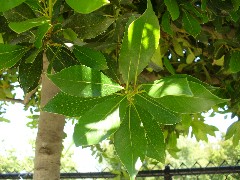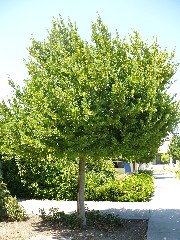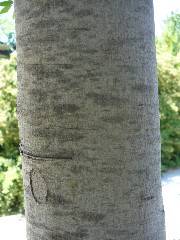Bay Laurel Tree
Laurus nobilisFamily: Lauraceae
Podcast Script
| One of the many Bay Laurel Trees at DHS. |
The smooth, furrowed bark of the Bay Laurel. |
 The aromatic leaves of the Bay Laurel. |
 Ripe purple berries of the Bay Laurel. |
Classification:
Angiosperm, Dicot, evergreenSize:
The Bay Laurel exists in many cultivars and varieties, all which vary in size. In general, Laurus nobilis is:- A roughly conical, shrublike tree.
- May be grown as standards, potted trees, shrubs, or tall trees.
- In the United States, usually grows 15 to 40 feet tall and 5 to 20 feet wide.
- In the Mediterranean, may reach heights of 60 feet.
Identifying Features:
Leaves:- Aromatic
- Glossy, dark green
- Elliptical or lanceolate
- Evergreen
- Up to 4 inches long
- Alternate
- Smooth, furrowed
- Dark or light gray
- Often/easily shaped for landscaping or topiary purposes
- Unpruned -- tends to spread outward rather than remain single-trunked.
- Compact and dense foliage
Location/Habitat:
Native of the Mediterranean region, Bay thrives in mild climates with plenty of sun. It must, however, have shelter from harsh winter winds and is often grown successfully as house plants or container plants. Bay is also tolerant of almost all soil types and pH.Flower/Fruit/Reproduction:
Flower:- Inconspicuous but highly aromatic
- Flowers in mid-spring
- Clusters of small, tight yellow blossoms
- Found on female trees in early autumn
- Mature from bright green to deep purple-black
- Inedible, but used for essential oils
- Perennial
- Dioecious; that is, separate male and female plants.
- Pollinated by bees
- Difficult to propogate through seeds--hardwood cuttings are usually taken.
Water/Sun Requirements:
Thrives in full sun with frequent watering, but care must be taken not to overwater. The soil should be well-drained and rich, and mulching is also beneficial during dry summer months to ensure adequate moisture.Special Adaptations:
A native of the Mediterranean, Laurus nobilis is slow-growing but highly drought tolerant. Its leaves are also evergreen and extremely resistant to injury. In fact, the tree in general is exceptionally resistant to disease and pests.Other Info:
Also known as Laurel, Bay, Sweet Bay, Grecian Laurel, Greek Bay, True Laurel.Featured prominently in folklore and mythology worldwide, especially Greek and Roman.
The bark, leaves, and fruits of Laurel have many medicinal and culinary uses.
Reference Sources/Links:
http://www.floridata.com/ref/L/laur_nob.cfmhttp://florawww.eeb.uconn.edu/acc_num/198500843.html
http://www.botanical.com/botanical/mgmh/l/larbay10.html
http://www.uni-graz.at/~katzer/engl/Laur_nob.html
http://www.worldwildlife.org/wildworld/profiles/terrestrial/pa/pa1207_full.html
http://florawww.eeb.uconn.edu/acc_num/198500843.html
http://www.uni-graz.at/~katzer/engl/Laur_nob.html
http://www.mccormick.com/content.cfm?id=8212
http://www.selfsufficientish.com/bay.htm
http://www.rhs.org.uk/WhatsOn/gardens/hydehall/archive/hydehallpom04dec.asp
http://selectree.calpoly.edu/treedetail.lasso?-MaxRecords=50&-SkipRecords=0&rid=804
http://zipcodezoo.com/Plants/L/Laurus_nobilis.asp
http://www.ibiblio.org/pfaf/cgi-bin/arr_html?Laurus+nobilis
http://www.theepicentre.com/Spices/bay.html
http://www.pfaf.org/database/plants.php?Laurus+nobilis
http://www.botany.hawaii.edu/faculty/carr/laur.htm
Created by Karen D. 2007.

